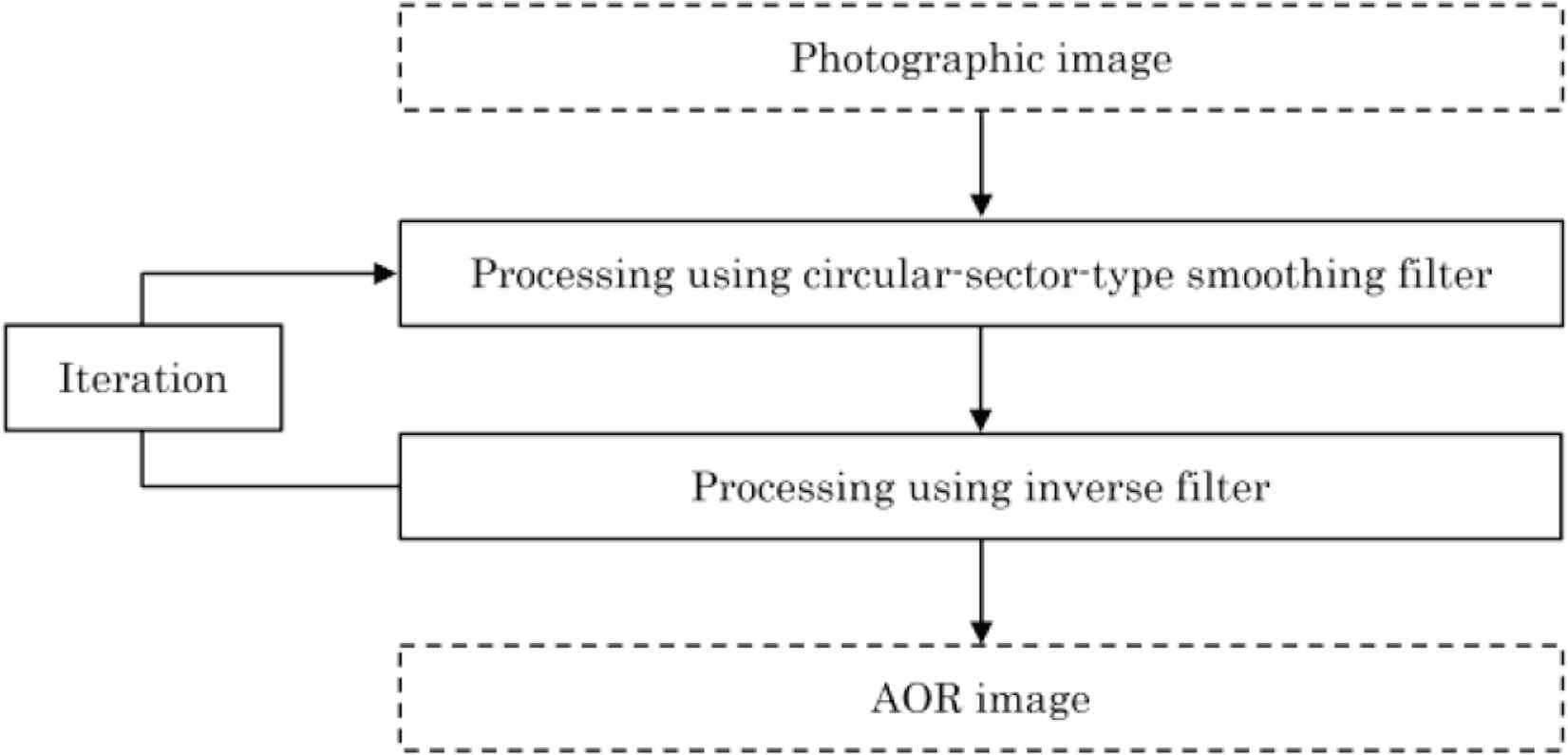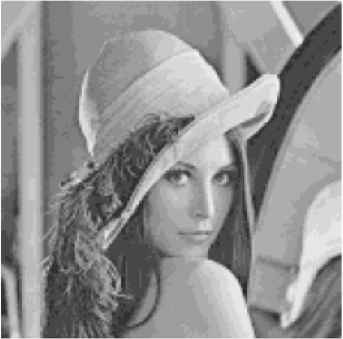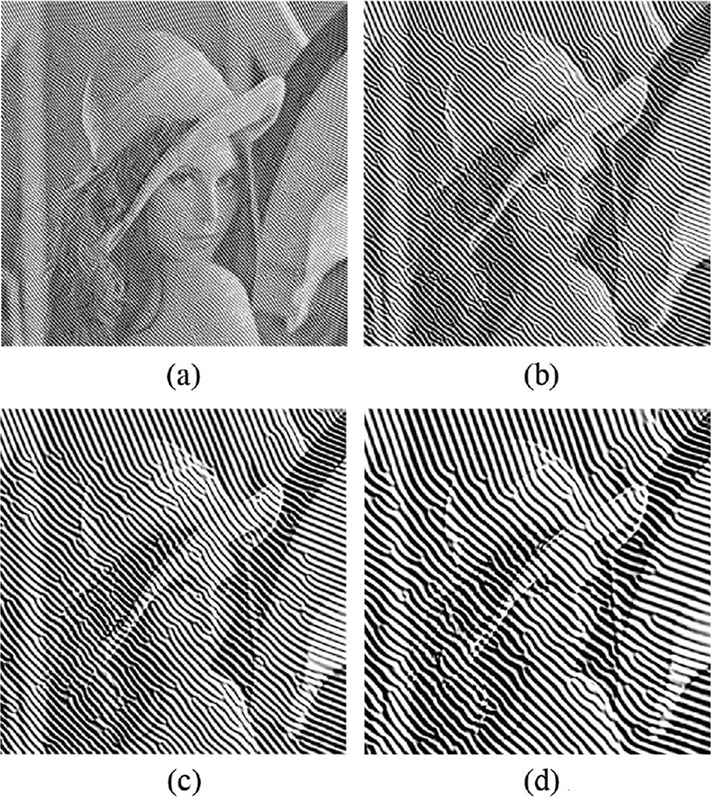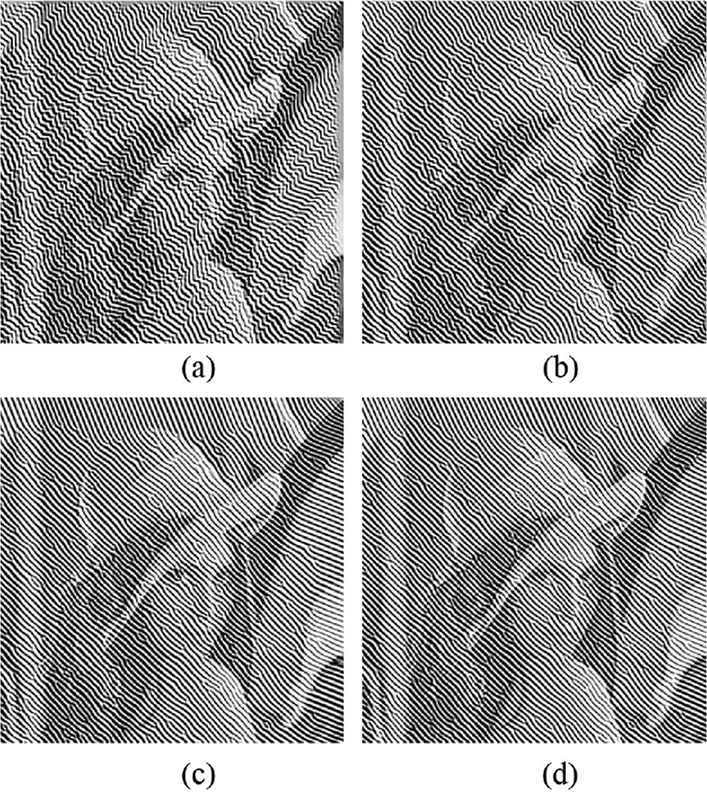Generation of Arbitrarily-Oriented Ripple Images using Circular-Sector-Type Smoothing Filter and Inverse Filter
- DOI
- 10.2991/jrnal.k.200222.001How to use a DOI?
- Keywords
- Non-photorealistic rendering; ripple pattern; arbitrarily orientation; circular-sector-type smoothing filter; inverse filter
- Abstract
A Non-photorealistic rendering method for generating ripple images from photographic images has been proposed using intensity gradient. Ripple patterns imitate a wave on the water surface and are composed of continuous lines with fluctuations. Ripple images are expressed by superimposing ripple patterns on photographic images. However, the conventional method can only generate vertical and horizontal ripple patterns. Therefore, in this paper, we develop a method that can generate ripple patterns in any orientation. Ripple images generated by the proposed method are called Arbitrarily-Oriented Ripple (AOR) images. The proposed method is executed by an iterative process using circular-sector-type smoothing filter and inverse filter. To verify the effectiveness of our method, we investigate the changes in AOR images by changing the values of the parameters.
- Copyright
- © 2020 The Authors. Published by Atlantis Press SARL.
- Open Access
- This is an open access article distributed under the CC BY-NC 4.0 license (http://creativecommons.org/licenses/by-nc/4.0/).
1. INTRODUCTION
Non-photorealistic Rendering (NPR) is a technology of computer graphics that can generate effective illustrations and artistic images. Many NPR methods have been proposed to simulate effective illustrations and artistic images [1–5]. In the past NPR methods, an NPR method for generating ripple images has been proposed [6]. Ripple patterns imitate a wave on the water surface and are composed of continuous lines with fluctuations. Ripple images are expressed by superimposing ripple patterns on photographic images. The conventional method was conducted by an iteration process with intensity gradients. Although the conventional method can generate ripple patterns in horizontal and vertical orientations, it is not possible to generate ripple patterns with arbitrary slope.
In this paper, we develop a method that can arbitrarily change the orientation of ripple patterns, then expand the range of expression of the conventional method. Ripple images generated by the proposed method is called Arbitrarily-Oriented Ripple (AOR) images. The proposed method is executed by an iterative process using inverse filter [7,8] and circular-sector-type smoothing filter. By adjusting the value of the parameter in the proposed method, ripple patterns of the proposed method is more linear or wavy than ripple patterns of the conventional method. In addition, by changing the value of the parameter, the proposed method can also change the interval between ripple patterns as the conventional method. To verify the effectiveness of the proposed method, experiments are conducted using Lenna image and other photographic images. As a result of the experiments, it is clarified that the proposed method can automatically generate AOR images. In addition, through experiments that change the values of parameters in the proposed method, it is also revealed the changes in appearance of AOR images.
The rest of this paper is organized as follows. Section 2 describes the proposed method for generating AOR images. Section 3 shows experimental results, and reveals the effectiveness of the proposed method. Finally, Section 4 concludes this paper.
2. PROPOSED METHOD
The proposed method is executed in two processes. In the first process, images are smoothed using circular-sector-type smoothing filter. In the second process, the smoothed images are restored using inverse filter. By repeating the two processes, AOR images are generated. Accumulation of errors due to the iterative process is a factor that can generate ripple patterns. A flow chart of the proposed method is shown in Figure 1. The detailed procedure in Figure 1 is shown as follows.

Flow chart of the proposed method.
The input pixel values for spatial coordinates (i, j) of a photographic image are defined as fi,j. Then, the pixel values of the image at the t-th iteration number are defined as
In the first process, the image with the pixel values

Conceptual diagram of circular-sector-type smoothing filter.
In the second process, the pixel values
In case
3. EXPERIMENTS
We mainly conducted two experiments. First, the experiment with changing the values of the parameters in the proposed method is conducted using Lenna image shown in Figure 3. Second, the experiment is conducted to verify that patterns can be generated using various photographic images shown in Figure 4. All photographic images used in the experiments are 512 * 512 pixels and 256 gradation.

Lenna image.

Various photographic images. (a) Airplane, (b) Barbara, (c) boat, (d) cameraman, (e) girl, (f) lighthouse, (g) text, (h) woman.
3.1. Experiment with Changing Parameters
Arbitrarily-oriented ripple images by changing the iteration number T are visually confirmed using Lenna image. The iteration number T is set to 10, 20, 50, and 100. Other parameters D, θ1, and θ2 are set to 5, π/2, and π/4, respectively. The results of the experiment are shown in Figure 5. As the value of the iteration number T is larger, ripple patterns become clear and converge.

AOR images in the case of the iteration number (a) T = 10, (b) T = 20, (c) T = 50, and (d) T = 100.
Arbitrarily-oriented ripple images by changing the radius D are visually confirmed using Lenna image. The radius D is set to 3, 5, 7, and 9. Other parameters T, θ1, and θ2 are set to 100, π/2, and π/4, respectively. The results of the experiment are shown in Figure 6. As the value of the radius D is larger, the intervals between ripple patterns become wider.

AOR images in the case of the radius (a) D = 3, (b) D = 5, (c) D = 7, and (d) D = 9.
Arbitrarily-oriented ripple images by changing the angle θ1 are visually confirmed using Lenna image. The angle θ1 is set to π/6, π/3, π/2, and (2/3)π. Other parameters T, D, and θ2 are set to 100, 5, and π/4, respectively. The results of the experiment are shown in Figure 7. As the value of the angle θ1 is larger, ripple patterns become more linear. On the other hand, as the value of the angle θ1 is larger, ripple patterns become wavier.

AOR images in the case of the angle (a) θ1 = π/6, (b) θ1 = π/3, (c) θ1 = π/2, and (d) θ1 = (2/3)π.
Arbitrarily-oriented ripple images by changing the angle θ2 are visually confirmed using Lenna image. The angle θ2 is set to 0, π/4, π/2, and (3/4)π. Other parameters T, D, and θ1 are set to 100, 5, and π/2, respectively. The results of the experiment are shown in Figure 8. Depending on the value of the angle θ2, the orientation of ripple patterns is changing.

AOR images in the case of the angle (a) θ1 = 0, (b) θ1 = π/4, (c) θ1 = π/2, and (d) θ1 = (3/4)π.
3.2. Experiment using Various Photographic Images
The proposed method is applied to eight photographic images shown in Figure 4. The parameters T, D, θ1, and θ2 are set to 100, 5, π/2, and π/4, respectively. The results of the experiment are shown in Figure 9. In all cases, ripple patterns can be automatically generated on the whole image. However, no ripple patterns are generated in the white areas shown in Figure 9f and 9g. It is conceivable to generate a ripple pattern by adding noise to the white area.

AOR images. (a) Airplane, (b) Barbara, (c) boat, (d) cameraman, (e) girl, (f) lighthouse, (g) text, (h) woman.
4. CONCLUSION
We proposed an NPR method for generating AOR images from photographic images. The proposed method was executed by an iterative process using inverse filter and circular-sector-type smoothing filter. To verify the effectiveness of the proposed method, the changes in AOR images by changing the values of the parameters were investigated. As a result of the experiments, by changing the value of the angle θ2 in the proposed method, ripple patterns could be generated in any orientation. And, by changing the value of the angel θ1, ripple patterns could be generated more linear or wavy.
And, by changing the value of the radius D, the proposed method could also change the interval between ripple patterns.
A subject for future study is to expand the proposed method for application to color photographic images and videos.
CONFLICTS OF INTEREST
The author declares they have no conflicts of interest.
ACKNOWLEDGMENT
This work was supported by
AUTHOR INTRODUCTION
Dr. Toru Hiraoka
 He graduated Doctor course at Design in Kyushu Institute of Design. He is a Professor in the Faculty of Information Systems in University of Nagasaki. His current research interests are non-photorealistic rendering and disaster prevention.
He graduated Doctor course at Design in Kyushu Institute of Design. He is a Professor in the Faculty of Information Systems in University of Nagasaki. His current research interests are non-photorealistic rendering and disaster prevention.
REFERENCES
Cite this article
TY - JOUR AU - Toru Hiraoka PY - 2020 DA - 2020/02/28 TI - Generation of Arbitrarily-Oriented Ripple Images using Circular-Sector-Type Smoothing Filter and Inverse Filter JO - Journal of Robotics, Networking and Artificial Life SP - 213 EP - 216 VL - 6 IS - 4 SN - 2352-6386 UR - https://doi.org/10.2991/jrnal.k.200222.001 DO - 10.2991/jrnal.k.200222.001 ID - Hiraoka2020 ER -
